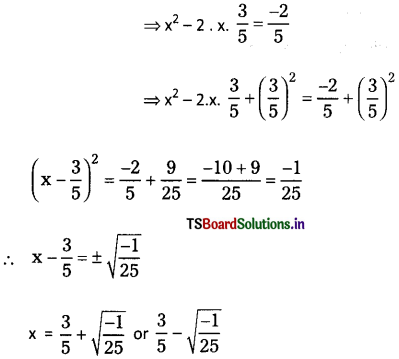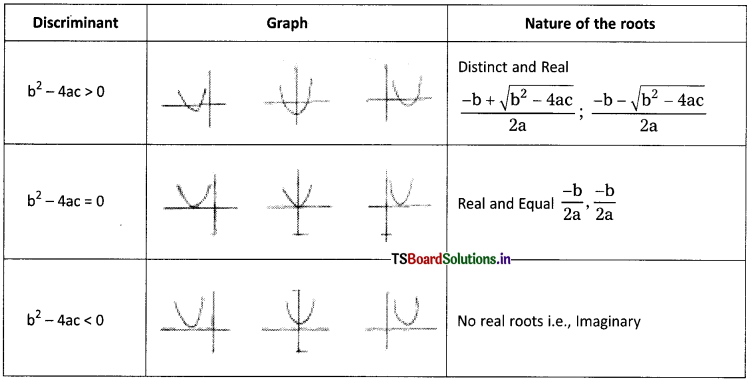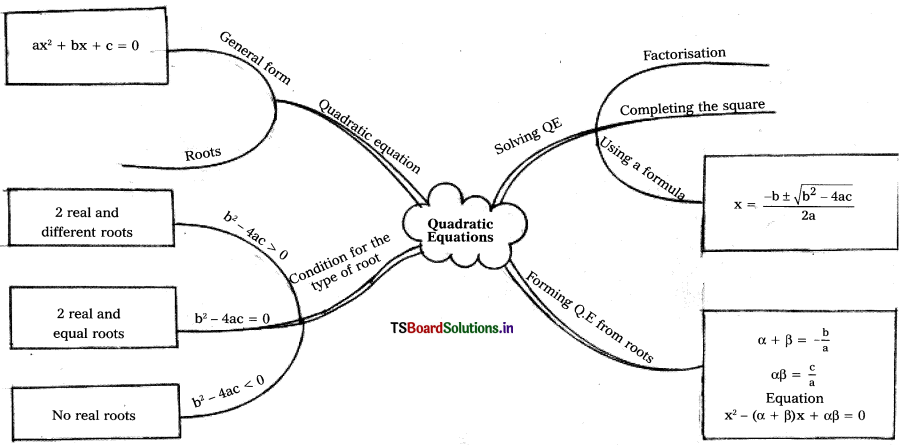We are offering TS 10th Class Maths Notes Chapter 5 Quadratic Equations to learn maths more effectively.
TS 10th Class Maths Notes Chapter 5 Quadratic Equations
→ The general form of a linear equation in one variable is ax + b = c.
→ Any equation of the form p(x) = 0 where p(x) is a polynomial of degree 2, is a quadratic equation.
→ If p(x) = 0 whose degree is 2 is written in descending order of their degrees, then we say that the quadratic equation is written in the standard form.
→ The standard form of a quadratic equation is ax2 + bx + c = 0 where a ≠ 0. We can write it as y = ax2 + bx + c.
→ There are various occasions in which we make use of Q.E. in our day-to-day life.
Eg : The height of a rocket is defined by a Q.E.
→ Let ax2 + bx + c = be a quadratic equation. A real number a is called a root of the Q.E. if aα2 + bα + c = 0. And x = a is called a solution of the Q.E. (i.e.) the real value of x for which the Q.E ax2 + bx + c = 0 is satisfied is called its solution.
→ Zeroes of the Q.E. ax2 + bx + c = 0 and the roots of the Q.E. ax2 + bx + c = 0 are the same.
![]()
→ To factorise a Q.E. ax2 + bx + c = 0, we find p, q ∈ R such that p + q = b and pq = ac.
This process is called Factorising a Q.E. by splitting its middle term.
Eg : 12x2 + 13x + 3 = 0
here a = 12; b = 13; c = 3
a.c = 12 × 3 = 36
b = 4 + 9 where 4 × 9 = 36
Now 12x2 + 9x + 4x +3 = 0
⇒ 12x2 + 9x + 4x + 3 = 0
⇒ 3x(4x + 3) + 1 (4x + 3) = 0
⇒ (4x + 3) (3x + 1) = 0
Here 4x + 3 = 0 or 3x + 1 = 0
⇒ 4x = -3 or 3x = -1
⇒ x = \(\frac{-3}{4}\) or x = \(\frac{-1}{3}\)
\(\frac{-3}{4}\) and \(\frac{-1}{3}\) are called the roots of the Q.E. 12x2 + 13x + 3 = 0 and x = \(\frac{-3}{4}\) or \(\frac{-1}{3}\) is the solution of the Q.E 12x2 + 13x + 3 = 0.
→ In the above example, (4x + 3) and (3x + 1) are called the linear factors of the Q.E. 12x2 + 13x + 3 = 0
→ We can factorise a Q.E. by adjusting its left side so that it becomes a perfect square.
Eg : x2 + 6x + 8 = 0 ⇒ x2 + 2. x. 3 + 8 = 0 ⇒ x2 + 2.x.3 = -8
The L.H.S. is of the form a2 + 2ab
∴ By adding b2 it becomes a perfect square
∴ x2 + 2.x.3 + 32 = -8 + 32
⇒ (x + 3)2 = -8 + 9
⇒ (x + 3)2 = 1
⇒ x + 3 = ±1
Now we take x + 3 = 1 or x + 3=-1
⇒ x = -2 or x = -4
→ Adjusting a Q.E. of the form ax2 + bx + c = 0 so that it becomes a perfect square.
Step -1: ax2 + bx + c = 0 ⇒ ax2 + bx = -c
⇒ x2 + \(\frac{b}{a}\)x = \(\frac{-c}{a}\)
Step – 2: x2 + \(\frac{\mathrm{bx}}{\mathrm{a}}+\left[\frac{1}{2}\left(\frac{\mathrm{b}}{\mathrm{a}}\right)\right]^2=\frac{-\mathrm{c}}{\mathrm{a}}+\left[\frac{1}{2}\left(\frac{\mathrm{b}}{\mathrm{a}}\right)\right]^2\)
Step – 3: \(\left(x+\frac{b}{2 a}\right)^2=\frac{b^2-4 a c}{4 a^2}\)
Step – 4: Solve the above
Eg: 5x2 – 6x + 2 = 0 ⇒ x2 – \(\frac{6 x}{5}=\frac{-2}{5}\)

→ Let ax2 + bx + c = 0 (a ≠ 0) be a Q.E., then b2 – 4ac is called the Discriminant of the Q.E.
→ If b2 – 4ac > 0, then the roots of the Q.E. ax2 + bx + c = 0 are given by
x = \(\frac{-b \pm \sqrt{b^2-4 a c}}{2 a}\). This is called quadratic formula to find the roots
→ The nature of the roots of a Q.E. can be determined either by its discriminant or its graph.
Q.E.: y = ax2 + bx + c.

![]()
Important Formulas:
- Quadratic Formula for find the roots x = \(\frac{-b – \sqrt{b^2-4 a c}}{2 a}\)
- Sum of the roots α + β = \(\frac{-b}{a}\)
- Product of the roots αβ = \(\frac{c}{a}\)
- Discriminant = b2 – 4ac
- If b2 – 4ac > 0 then the roots are real and distinct.
- If b2 – 4ac = 0 the roots are real and equal.
- If b2 – 4ac < 0 then the roots are not real.
Flow Chat:

Al – Khwarizmi (780 – 850):
- Muhammad ibn Musa al-Khwarizmi was a Persian mathematician, astronomer, astrologer and geographer, it He was born around 780 A.D. in Khwarizmi (now Khiva, Uzbekishtan) and died around 850.
- He worked most of his life as a scholar in the House of Wisdom in Baghdad, it His ‘Algebra’ was the first book on the systematic solutions of linear and quadratic equations.